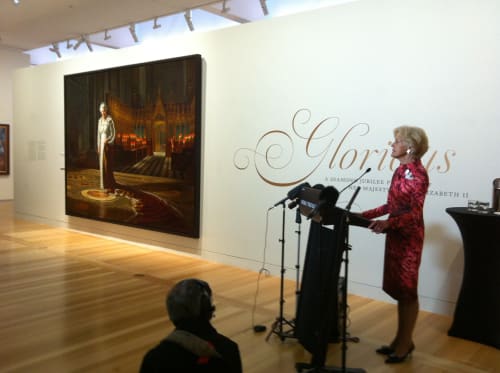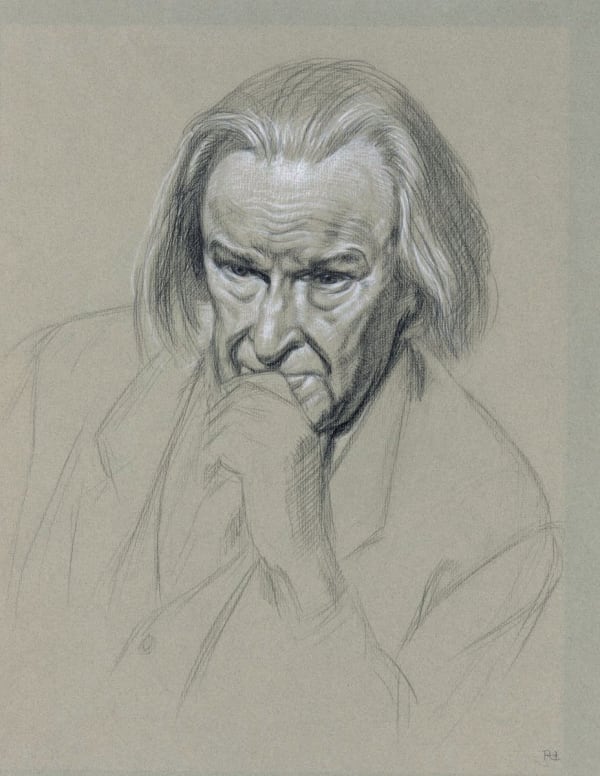Glorious: A DIAMOND JUBILEE PORTRAIT OF HER MAJESTY QUEEN ELIZABETH II: The National Portrait Gallery of Australia
Glorious: A Diamond Jubilee portrait of Her Majesty Queen Elizabeth II, is a collection-based display representing The Queen in the early and late years of her glittering sixty-year reign. The highlight of the display is the unveiling of this year's only official painted portrait of The Queen, by Australian-born portraitist, Ralph Heimans. Shown for the first time, the portrait of Her Majesty Queen Elizabeth II in her Diamond Jubilee year will be displayed alongside works from the Gallery's collection of Australians upon whom The Queen has bestowed honours.
IMAGINE
By Dr Sarah Engledow, Historian, the National Portait Gallery of Australia
Elizabeth the Second, by the Grace of God Queen of Australia and Her other Realms and Territories, Head of the Commonwealth, acceded to the throne in 1952 and was crowned in the Collegiate Church of St. Peter, Westminster (commonly known as Westminster Abbey) on 2 June 1953. When The Queen came to Australia in 1954, it was the first time the country had been visited by a reigning monarch. On that occasion, The Queen opened Parliament in Canberra wearing her white wasp-waisted Coronation dress. She has made fifteen visits to the country since. She came for the fiftieth anniversary of the naming of Canberra in 1963; for the bicentenary of James Cook’s Endeavour landing in 1970; to open the Sydney Opera House in 1973; to celebrate her Silver Jubilee in 1977; to attend the Commonwealth Games in Brisbane in 1982; to open the new Parliament House in Canberra in 1988; to attend the Commonwealth Heads of Government Meeting in 2002; and to open the Commonwealth Games in Melbourne in 2006. She last visited in late 2011.
The year 2012 marked the sixtieth anniversary of The Queen’s coronation. In response to the Diamond Jubilee, Australian-born artist Ralph Heimans proposed a portrait of The Queen. Heimans acted on his own initiative, but was encouraged by The Hon Michael Kirby AC CMG, whom he painted for an arresting portrait titled Radical Restraint – acquired by the National Portrait Gallery in 2001. The Australian High Commissioner in London, John Dauth, assisted the artist in his approaches to Buckingham Palace; National Portrait Gallery Director Louise Doyle agreed that if official approval were obtained, the Gallery would display it upon its completion in late 2012.
In the middle of February 2012, although he had had no firm news from Buckingham Palace, Heimans travelled to London to develop his ideas. Soon, he found himself enthralled by the beauty and history of Westminster Abbey. It was there, at a Commonwealth Day service on 12 March, that he first saw The Queen in person. He tried to imagine her thinking back to her Coronation in the Abbey sixty years before, and the weight of responsibility she was bound to feel on that day.
On 21 March 2012, when Heimans arrived at Buckingham Palace for a sitting in the Yellow Drawing Room, he knew that he had been allocated an hour, but learned that Her Majesty would be pleased if he finished sooner. After fifty minutes’ work, he left with a resolved concept of the figure of The Queen and the reflective mood of the portrait. He wrote later that he found it inspiring to be in the presence of The Queen, and returned to his studio wanting to produce a painting of enduring significance, worthy of her remarkable anniversary.
Heimans’s portrait shows The Queen in her beloved Abbey, in the ‘Coronation Theatre’ before the High Altar, the lamps lit in the Quire behind her. She stands at the spot on which every English monarch since 1066 has been crowned, near the circle of onyx at the centre of the recently-restored thirteenthcentury mosaic called the Cosmati Pavement. On her shoulders lies the Robe of State, which she wore for her Coronation, and she wears diamonds that belonged to Queen Victoria.
At the National Portrait Gallery, Heimans’s huge painting is displayed next to William Dargie’s portrait of the young monarch in the ‘Wattle dress’ that she wore on her Australian tour in 1954. By the time The Queen came to the throne, many Australian citizens had received British Imperial honours. In the current display, titled Glorious, around the two portraits of The Queen are paintings, photographs and sculptures of Australians upon whom she conferred knighthoods or other special honours between 1953 and 1992, when the Federal and State governments announced that no longer would any Australian citizen be recommended for an Imperial award.
In The Coronation Theatre The Queen stands alone; for, the artist says, ‘even when she is surrounded by people she cuts something of a solitary figure. She has had such a unique and singular experience on this earth.’ Just as the real Queen must maintain her composure in the face of incessant observation, Heimans’s painted Queen, ruminative in the silent space of the Abbey on the canvas, has been scrutinised, dissected and analysed by thousands of excited visitors to the Gallery. Their delight in the portrait indicates the affection in which the Sovereign is held by generations of Australians who have aged along with her; as well as their appreciation of the young artist’s enterprise, vision, patience and talent.
-
 The Coronation Theatre: Her Majesty Queen Elizabeth II2012
The Coronation Theatre: Her Majesty Queen Elizabeth II2012
Oil on canvas -
 Radical Restraint: Justice Michael Kirby1998
Radical Restraint: Justice Michael Kirby1998
Oil on canvas183,1 x 228,7 cm
National Portrait Gallery, Canberra (purchased with funds from the Basil Bressler Bequest 2001)
-
 Gloves Off: Tom Uren1996
Gloves Off: Tom Uren1996
Oil on canvas122 x 152
National Portrait Gallery of Australia -
 Emeritus Professor Derek Freeman199640 x 32 cm
Emeritus Professor Derek Freeman199640 x 32 cm
National Portrait Gallery of Australia




